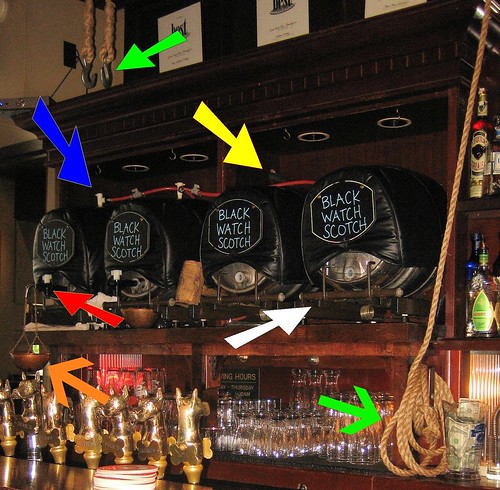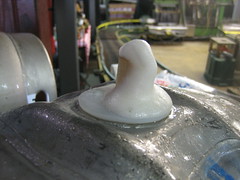
What is 'cask-conditioned' ale —often referred to as 'real ale'? CAMRA (the Campaign for Real Ale in the U.K.) has this handy definition:
a natural product brewed using traditional ingredients and left to mature in the cask (container) from which it is served in the pub through a process called secondary fermentation. It is this process which makes real ale unique amongst beers and develops the wonderful tastes and aromas which processed beers can never provide.
Most pubs and brewpubs in the U.S. serving cask-conditioned real ales keep their casks in refrigerated units under the bar counter or in a cold room, out-of-sight from most of their customers. The beer is pulled to the bar spigot —without extraneous carbon dioxide or nitrogen gas— via a handpump known as a 'beer engine.'
There's, of course, nothing wrong with a beer engine, but there's no magic connected with its use either. It does nothing to preserve or protect the beer. In fact, it's not a powered engine at all, but a simple conveyance: a hand-operated piston pump that pulls beer from one location to another. When a 'sparkler' is attached to the spigot, the beer engine helps create a pretty head on the beer. It does so, however, at the expense of the carbonation (already scant) in the beer.
****************
Elevating casks: a gravity-pour system
Sitting at the bar among 'standard' CO2 taps, the lever of a beer engine can appear to the cask-uninitiated to be just another tap, if a tad unusual. But at The Great Dane Brewpub —at its downtown Madison, Wisconsin, location, within sight of the state's Capitol dome— even a casual glance reveals its elevated casks to be something apart.Four firkins (10.8 gallon casks) of Black Watch Scotch Ale sit behind and above the bar, in full view of customers.
-
Green arrows
- No lifting of full casks over one's head (at 114 pounds, give or take). A winch and pulley system is used to raise and lower the firkins.
- Red arrow
- A tap has been hammered into the keystone of the firkin. The bartender simply gives the tap a quarter-turn and the beer flows out. This is called a gravity tap.
Notice that only beer from that one cask is being served. The other casks are coming into condition, that is: the cask has been vented to bring the level of carbonation to a proper equilibrium and to give the solids in the beer (yeast, protein break, hops) time to settle below the tap so that the beer will be 'bright' and unmurky when served. A shower of beer out of the shive bung might be dramatic but is poor cellarmanship: wasteful and injurious to the quality of the beer.
Not 'arrowed' is an ash mallet which is used to hammer in the taps. It can be seen resting, waiting, between the 2nd and 3rd casks.
- A tap has been hammered into the keystone of the firkin. The bartender simply gives the tap a quarter-turn and the beer flows out. This is called a gravity tap.
- Orange arrow
- A copper drip bucket sits under the tap. No muss, no fuss! By the way, there could have been casks of other beers set in place on the shelf. Cask-conditioned real ale is a method of serving a beer, not necessarily of any particular beer style. Great Dane serves Black Watch only as real ale, not 'standard' draft.
- Blue arrow
- Part of the appeal of cask-conditioned real ale is that no extraneous gas —be it CO2 or nitrogen— is added to the beer. It is served as it was when it fermented.
When a cask is vented, air is allowed to enter the top shive bung of the cask so that beer can be poured from the tap in the keystone. If a cask is emptied within 24 hours, that is not a problem; longer than that and the beer may become sour from airborne contaminants and go flat, lose its carbonation.
The arrow points to the cask end of a device called a cask breather: a diaphragm valve that provides a blanket of protective carbon dioxide over a cask ale but at zero additional pressure. One end is connected to a tank of carbon dioxide; the other to the tut in the top shive bung. When beer is pulled or poured from a cask, the valve opens allowing an identical volume of CO2 to flow into the cask —at barometric pressure, thus, at 0 psi— and sit atop the remaining beer. The beer gains no additional pressure.
- Part of the appeal of cask-conditioned real ale is that no extraneous gas —be it CO2 or nitrogen— is added to the beer. It is served as it was when it fermented.
- Yellow arrow
- A pernicious, if common, misconception is that cask-conditioned real ale is served at room temperature. This is so not true. Doing so would be quite un-refreshing. Real ale is served at what is known as 'cellar' temperature: 50-54 °F. Not as cold as draft service, this temperature allows the fuller flavors of the cask ale to be expressed. But it is definitely not warm!
The yellow arrow points to a coolant line. It runs to twisted copper saddles which straddle each cask underneath their black insulated jackets. The coolant keeps the beer inside the firkins a cool cellar temperature.
- A pernicious, if common, misconception is that cask-conditioned real ale is served at room temperature. This is so not true. Doing so would be quite un-refreshing. Real ale is served at what is known as 'cellar' temperature: 50-54 °F. Not as cold as draft service, this temperature allows the fuller flavors of the cask ale to be expressed. But it is definitely not warm!
- White arrow
- The firkin sits on spring-loaded trestle known as a 'auto-tilt.' When the cask is full, it depresses the spring and sits nearly horizontally. As it is drained, the spring releases accordingly, allowing the cask to tilt at an ever greater angle. A publican wouldn't want to serve the final dregs from a cask, but there is a substantial amount of beer which is still bright and clear sitting beneath the level of the keystone and tap which she would want to serve.
**************
How was the beer?
Oh, and the Black Watch Scotch Ale itself? Dark russet in color, with flavors of dark fruit (almost Concord grape), bourbon, and caramel malt. 6.2% alcohol-by-volume (abv).
After all that, I'll mention that Great Dane does also offer a cask ale pulled via beer engine!
-----more-----
- See more photos from my August 2009 visit to the brewpub: here.
- Butt size, and other cask maths: the volumes and dimensions of beer casks.
- For more from YFGF:
- Follow on Twitter: @Cizauskas.
- Like on Facebook: YoursForGoodFermentables.
- Follow on Flickr: Cizauskas.
- Follow on Instagram: @tcizauskas.









No comments:
Post a Comment
Comment here ...